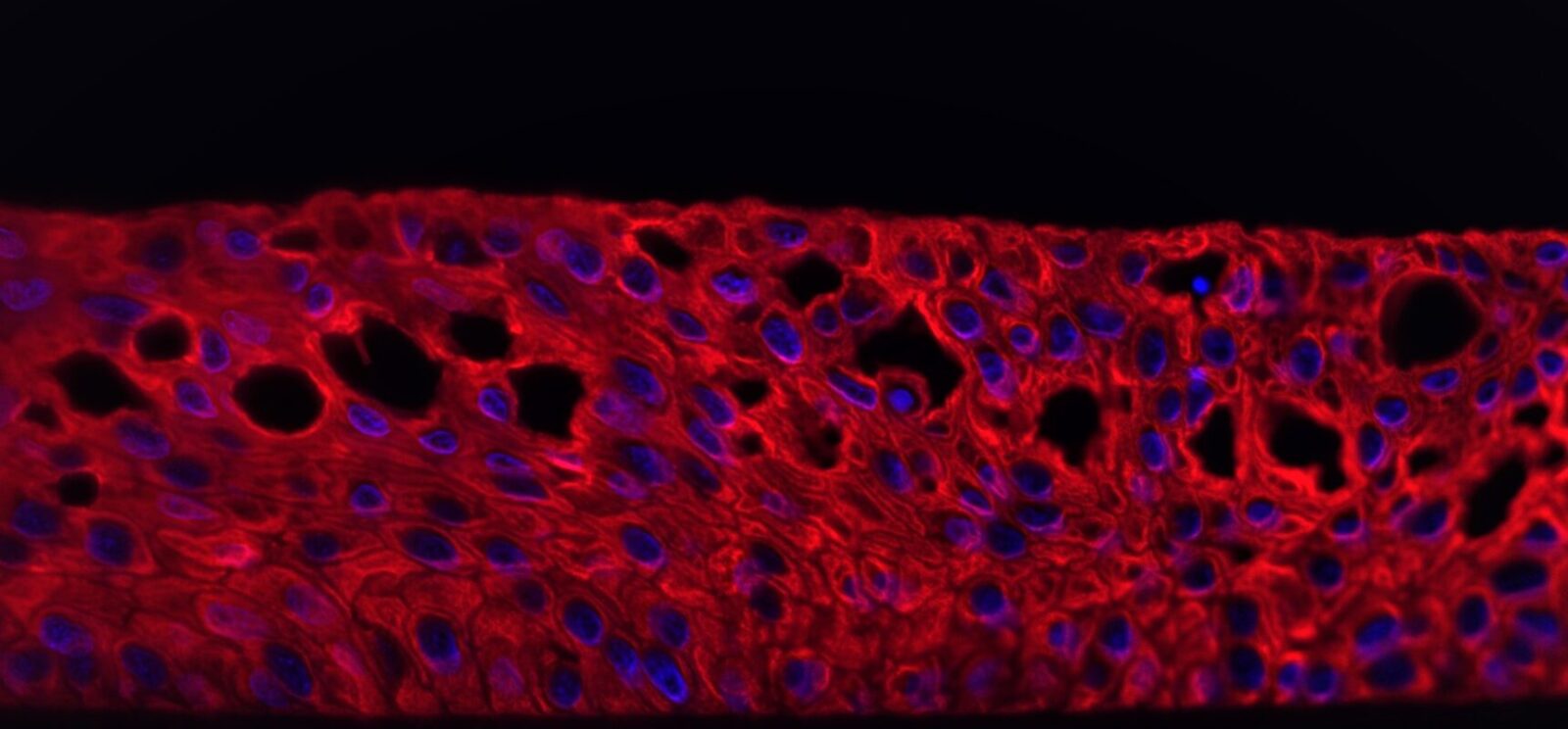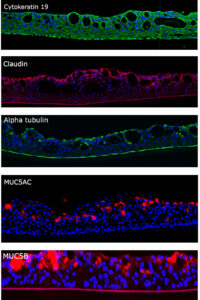

EpiNasal exhibits human relevant tissue structure and cellular morphology with high uniformity and reproducibility. Its 3D structure consists of CK19+ epithelial cells, functional tight junctions (Claudin), beating cilia (alpha-tubulin), mucus producing goblet cells (MUC5AC, MUC5B), and the SARS-CoV-2 entry-related virus receptors (ACE-2, TMPRSS2)


The EpiNasal 3D human tissue model is utilized for a range of applications including the study of respiratory syncytial virus infections, increased release of matrix metalloproteases in response to viral infections, anti-viral research, intranasal drug delivery, and safety & risk assessment (nasal irritation of inhaled therapeutics). In short, the 3D nasal tissue model with a polarized and multilayer tissue structure will serve as a valuable tool to predict safety of chemical inhalants, therapeutic candidates, and viral and bacterial infections. The protocols allow scientists to acquire data in days, not weeks or months.
Viral Infection
Use EpiNasal to study respiratory viral attachment, replication, and innate immune responses and for anti-viral drug development.
Permeation
EpiNasal’s cell culture insert format allows for direct determination of API permeation and flux.
Inhalation Toxicology
Use EpiNasal to determine relative safety of nasal sprays and intranasal drug formulations using the MTT and TEER assays and inflammatory responses.
Inhalation Toxicology Reference
Tissue
Kit: The EpiNasal kit (NAS-100) consists of 24 tissues. (Tissue “kits” contain tissues, culture medium, and plasticware; contact MatTek for specific kit contents)
Formats: 9mm individual inserts with microporous membrane bottom (pore size 0.4 μm). The membrane is coated with an extracellular matrix.
Culture: Air-liquid interface
Histology: Pseudostratified, mucociliary morphology and tissue structure
Lot numbers: Tissue lots produced each week are assigned a specific lot number. A letter of the alphabet is appended to the end of the lot number to differentiate between individual kits within a given lot of tissues. All tissue kits within a lot are identical in regards to cells, medium, handling, culture conditions, etc.
Shipment: At room temperature on medium-supplemented, agarose gels
Shipment day: Every Other Monday
Delivery: Tuesday morning via FedEx priority service (US). Outside US: Tuesday-Thursday depending on location
Shelf life: Including time in transit, tissues may be stored at RT for up to 72 hours prior to use; however, use of the tissue upon receipt or following overnight storage is recommended. In addition, the best reproducibility will be obtained if tissues are used consistently on the same day, e.g. Wednesday morning following overnight storage.
Length of experiments: Tissue cultures can be continued for two weeks or more with good retention of normal morphology. Tissues must be fed every other day with 5.0 mL of maintenance medium (NAS-100-MM). Use HNG-TOP-12 plates to allow for feeding cell culture inserts with 5.0 mL of medium.
Cells
Type: Normal human nasal epithelial cells
Genetic make-up: Single donor
Derived from: Healthy, non-smoker
Screened for: HIV, Hepatitis-B, Hepatitis-C, mycoplasma
Medium
Base medium: Dulbecco’s Modified Eagle’s Medium (DMEM)
Growth factors/hormones: Epidermal growth factors and other proprietary factors
Serum: None
Antibiotics: Gentamicin 5 µg/ml (10% of normal gentamicin level)
Anti-fungal agent: Amphotericin B 0.25 µg/ml
pH Indicator: Phenol red
Other additives: Proprietary
Alternatives: Phenol red-free, antibiotic-free, anti-fungal-free medium and tissues are available. Agents are removed at least 3 days prior to shipment.
Assay medium: NAS-100-ASY
Maintenance medium: NAS-100-MM
Quality Control and Sterility
Visual inspection: All tissues are visually inspected and if physical imperfections are noted, tissues are rejected for shipment
End-use testing: Transepithelial electrical resistance (TEER) of each EpiNasal lot is measured using an EVOM epithelial Volthommeter and Endohm electrode chamber (World Precision Instruments).
Sterility: All media used throughout the production process is checked for sterility. Maintenance medium is incubated without antibiotics for 1 week and checked for sterility. The agarose gel from the 24-well plate used for shipping is also incubated for 1 week and checked for any sign of contamination.
Screening for pathogens: All cells are screened and are negative for HIV, hepatitis B and hepatitis C using PCR. However, no known test method can offer complete assurance that the cells are pathogen free. Thus, these products and all human derived products should be handled at BSL-2 levels (biosafety level 2) or higher as recommended in the CDC-NIH manual, “Biosafety in microbiological and biomedical laboratories,” 1998. For further assistance, please contact your site Safety Officer or MatTek technical service.
Notification of lot failure: If a tissue lot fails our QC or sterility testing, the customer will be notified and the tissues will be replaced without charge when appropriate. Because our QC and sterility testing is done post-shipment, notification will be made as soon as possible (Under normal circumstances, TEER failures will be notified by Wednesday 5 p.m.; sterility failures will be notified within 8 days of shipment).
Thank you for requesting information about MatTek products! A representative will contact you shortly.
**If you would like to place an order for MatTek products, please contact Customer Service**


